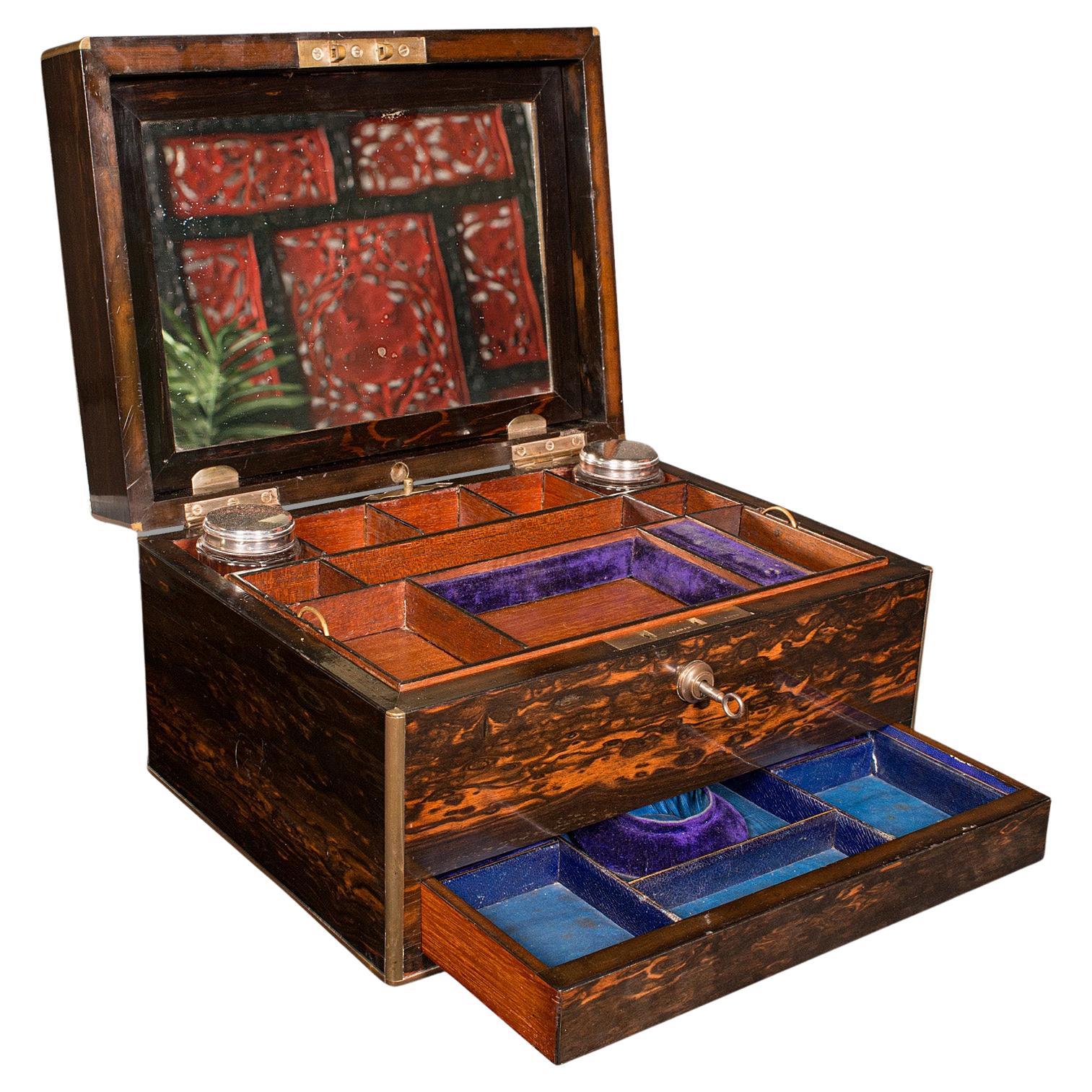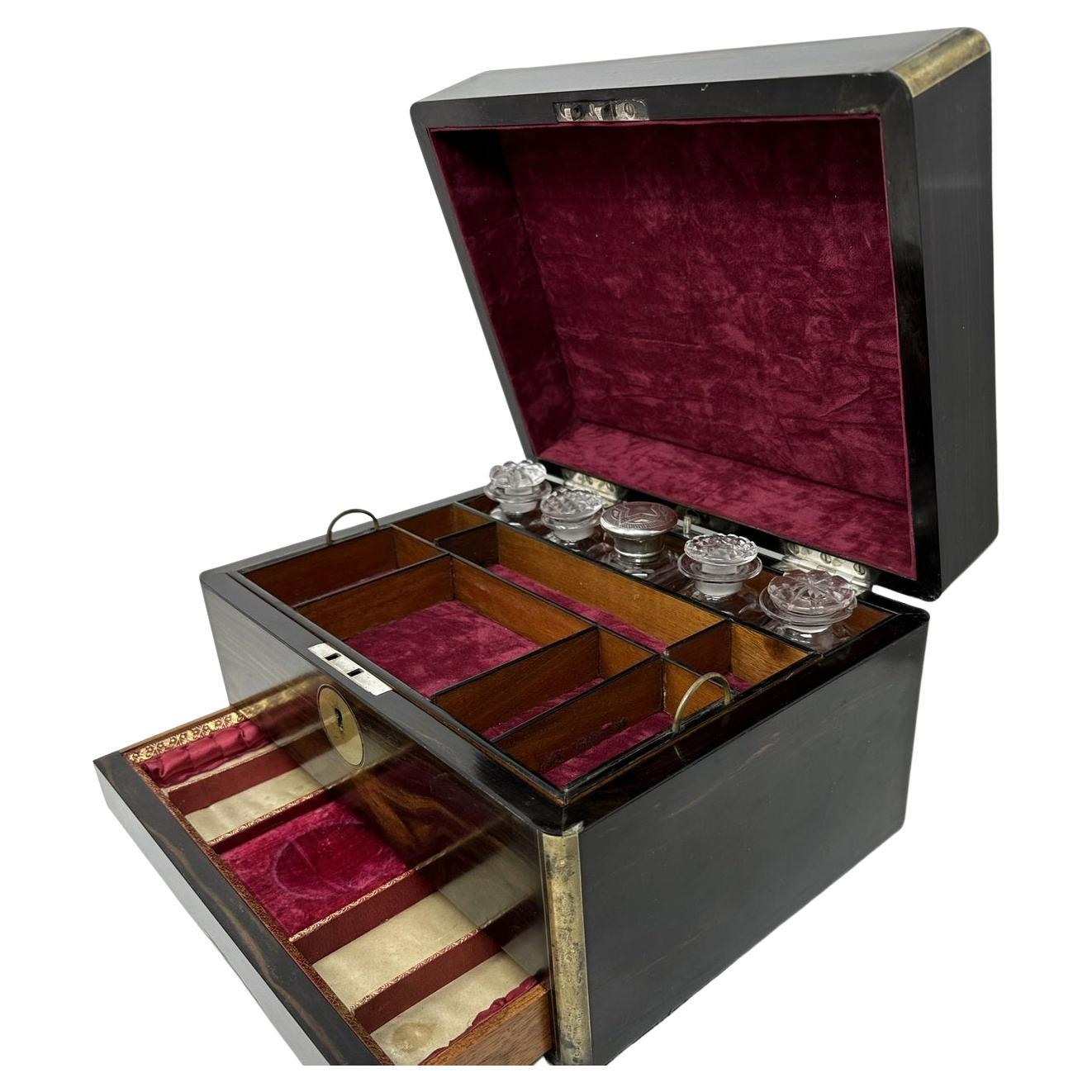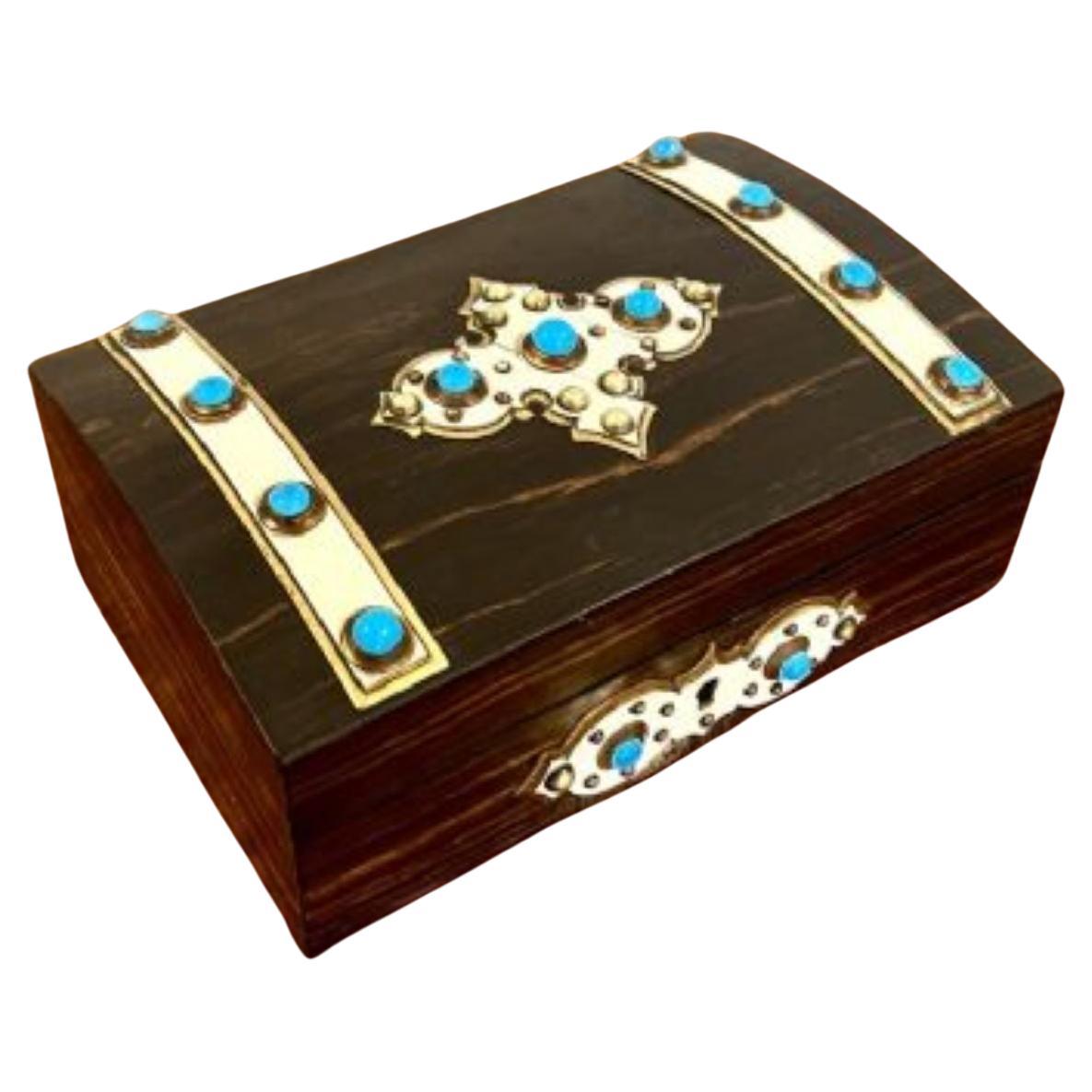Items Similar to Victorian Coromandel Vanity Box Glyn Cywarch Estate
Want more images or videos?
Request additional images or videos from the seller
1 of 19
Victorian Coromandel Vanity Box Glyn Cywarch Estate
About the Item
Dating to 1857 hallmarks for James Vickery and makers plaque Henry Lewis
From our Vanity Box collection, we are delighted to offer this exceptional Victorian Coromandel Vanity Box from the Glyn Cywarch Estate. The box veneered in exotic Coromandel bound and double strung in brass with solid brass campaign carry handles and an engraved circular escutcheon. To the lid, an initial plaque sits to the centre bordered by further brass stringing with an initial monogram reading GHME. When opened the Vanity Box reveals twelve hand-cut hobnail glass containers finished with heavily engraved Silver lids with a central letter G encrusted with rubies and turquoise stones. Each lid is gilded to the inside and hallmarked Sterling Silver James Vickery, London 1857. The glass containers held in Royal blue velvet partitions. The inner lid of the Box is fitted with a stand alone mirror having the original mirror plate which is beautifully engraved around the proximity with a ruched velvet rear upon a royal blue silk water paper completing the rear bracket. When removed, the mirror reveals the hidden document storage to the rear with fold out pouch. The top tray is surrounded by beautifully engraved brasswork on the lock plates and hinges. The front lock plate signed Henry Lewis, Goldsmith, Jeweller & Dressing Case Maker, 7. New Bond St. London. W.
The front centre of the top tray houses a small catch which presses down to allow access to the drop down front which is fitted with a selection of Mother of Pearl tools and various accoutrements including three pairs of scissors, silver corkscrew and a Mother of Pearl hand mirror. The middle drawer opens at the engraved brass handle and houses a selection of vanity accessories including brushes and glove stretchers which all contain the matching monogram found on the lid. Below the middle drawer is a hidden drawer which does not feature any handle, it can be accessed by pushing the central screw at the back of the tray. Once the screw is pushed down the tray springs open to access the partitioned drawer for storing higher value objects such as watches and rings. A second hidden compartment is located beneath this drawer which can only be accessed once the first hidden drawer is fully removed. Once removed the floor of the compartment can be pushed back and then lifted to access the final secret storage box.
This exceptional box is from the collection of Lord Harlech and was part of the Glyn Cywarch property.
Coromandel is a valuable wood found in India, Sri Lanka and South East Asia. It has a contrasting hazel-brown colour with black grain. It is a dense, heavy wood that is so popular it has been logged to extinction over the last few hundred years. This makes Calamander pieces even more special.
Glyn Cywarch is located near Talsarnau the Ardudwy area of Gwynedd in Wales. It is a Grade II listed manor house and it originally belonged to a branch of the Wynn family, descended from Osbwrn Wyddel. The present house was built for William and Kathryn Wynn in 1616. It is an ambitious gentry house of Renaissance character. The house displays a distinctive layout comprising two linked dwellings one to the rear of the main house originally facing away from it is a smaller block, with a secondary dwelling (dower house). The two were linked by the rear wing of the main house which was also later extended with the addition of another wing in parallel during restoration in the 1870s.
The original layout of the property conformed to a regional sub-medieval pattern of hall (originally with lateral fireplace) and parlour in the main range. Renaissance influence is suggested by the housing of a well-stair and kitchen in a rear wing. This layout does not survive intact, but original detail of a high order relating to this original plan survived. There is a fine plasterwork overmantel to the parlour fireplace which houses an armorial panel and flanking figures of Adam and Eve. There are also similarly enriched fireplaces to the first floor chambers featuring plaster armorial panels as overmantels, dated 1638 and 1639. Leading from the front range to the rear kitchen wing, a fine Jacobean door is resited, probably from Clenenney. Panelling on the upper landing was brought from Penrhos Old Hall, Montgomeryshire. In the former secondary dwelling inscriptions painted by Ellis Wynn, third son of William and Kathryn.
In the 17th century, the estate came by marriage into the hands of the Owens of Clenenney and Brogyntyn, and for most of the 18th century Glyn was the agent’s house, but in the 19th century, the property began to be used for summer visits. It remains with the same family (despite several name changes due to passing through the female line), and is still a secondary house, a fact which may have contributed to its survival without major alteration. However, the fact that the family title, conferred in 1876, is Baron Harlech may indicate that the estate was always considered of importance to the family.
Baron Harlech of Harlech in the County of Merioneth is a title in the Peerage (nobility) of the United Kingdom. It was created in 1876 for the Conservative politician John Ormsby-Gore. He had previously represented Carnarvon and North Shropshire in the House of Commons. Ormsby-Gore was the eldest son of William Ormsby-Gore, Member of Parliament for County Leitrim, Carnarvon and North Shropshire, and the great-great-great-grandson of William Gore, third and youngest son of Sir Arthur Gore, 1st Baronet, of Newtown, second son of Sir Paul Gore, 1st Baronet, of Magharabag, whose eldest son Paul was the grandfather of Arthur Gore, 1st Earl of Arran.
Lord Harlech was succeeded according to the special remainder by his brother William, the second Baron. He was a former Conservative Member of Parliament for County Sligo and County Leitrim and also served as Lord Lieutenant of County Leitrim for many years. His son, the third Baron, represented Oswestry in the House of Commons as a Conservative between May 1901 - June 1904. And he also served as Lord Lieutenant of County Leitrim and of Merionethshire. He was succeeded by his son, the fourth Baron. He was a Conservative politician and notably served as Postmaster-General, First Commissioner of Works and Secretary of State for the Colonies. His second but eldest surviving son, the fifth Baron, was a prominent Conservative politician and diplomat. From 1961 to 1965 he served as British Ambassador to the United States. As of 2016, the title is held by his grandson, the seventh Baron, who succeeded in 2016.
The family seat is Glyn Cywarch, near Talsarnau, Gwynedd, Wales.
James Vickery was recorded as a silversmith in 1852 located at 4, Woodbridge Street, Clerkenwell. By 1855 he had relocated to 20, King Square, Goswell Road, Clerkenwell and then again by 1880 to 11, Lavers Road, Stoke Newington. He was a known maker of Silver fittings used in dressing cases. James Vickery entered his first mark at the London Assay Office on the 5th of August 1851, and a further mark on the 8th of November 1880.
Henry Lewis est. Circa 1876 was a Goldsmith, Jeweller & Dressing Case Maker located at 7 & 172 New Bond Street, London and 109 Mount Street, London.
Measurements (centimetres) 22.5cm High x 36cm Wide x 28cm Deep
- Creator:Henry Lewis (Manufacturer),James Vickery (Metalworker)
- Dimensions:Height: 8.86 in (22.51 cm)Width: 14.17 in (36 cm)Depth: 11.02 in (28 cm)
- Style:Victorian (Of the Period)
- Materials and Techniques:
- Place of Origin:
- Period:
- Date of Manufacture:1857
- Condition:
- Seller Location:Northampton, GB
- Reference Number:
About the Seller
No Reviews Yet
Vetted Seller
These experienced sellers undergo a comprehensive evaluation by our team of in-house experts.
Established in 1998
1stDibs seller since 2023
12 sales on 1stDibs
- ShippingRetrieving quote...Ships From: Northampton, United Kingdom
- Return PolicyA return for this item may be initiated within 14 days of delivery.
More From This SellerView All
- Victorian Mappin & Webb Antique Silver Coromandel Vanity / Dressing BoxBy James Vickery, Mappin & WebbLocated in Northampton, GBAntique Vanity Box / Dressing Box with its original leather carry case. The silver vanity box itself is veneered in exotic coromandel with brass ...Category
Antique 19th Century British Jewelry Boxes
MaterialsBrass
- Victorian Burr Walnut Fitted Vanity BoxLocated in Northampton, GBFitted With Silver & Mother of Pearl From our Vanity Box collection, we are pleased to offer this Victorian Burr Walnut Vanity Box. The Vanity Box of rectangular form veneered in B...Category
Antique Late 19th Century Jewelry Boxes
MaterialsSilver, Sterling Silver
- Coromandel Jewellery Box with Perfume BottlesLocated in Northampton, GBRare Small Sized Jewellery Box From our Jewellery Box collection, we are delighted to offer this Rare example small sized Jewellery Box. The Jewellery Box of square shape constructe...Category
Early 20th Century English Edwardian Jewelry Boxes
MaterialsSilver, Sterling Silver
- Amboyna Vanity Box Joseph Rodgers & SonsBy Joseph Rodgers & SonsLocated in Northampton, GBAntique Silver Gilt Vanity Box veneered in stunning Amboyna. From our Vanity boxes, we are delighted to offer this stunning Amboyna veneered vanity box. The box with quadrant brass edging and matching escutcheon surrounding the Amboyna veneered exterior with side flush mounted recessed handles. The box is labelled with "Joseph Rodgers & Sons" of Sheffield, cutler to her Majesty" with exquisitely engraved silver-gilt lids upon glass bottles by London Silversmith, Thomas Johnson. The lock plate is stamped with the registration number and makers mark Chubb & Son, locksmiths to her majesty. The lid features a fold-down letter compartment with a removable mirror behind it. The base has a fabulous assortment of thirteen superb-cut glass bottles with exquisitely engraved sterling silver gilt & pierced jars. Unusually, the back five jars rise when the box is opened, a rare and desirable addition to this vanity box. The front features two drawers, one is vacant while the other is for storing jewellery; containing a removable accoutrements pad with various tools. This silver-gilt vanity box comes with a fully working lock and tasselled key. Joseph Rodgers & Sons was founded in 1724 when John Rodgers first rented the star and Maltese cross mark from the Cutlers’ Company. Rodgers & Sons had a reputation for producing the best quality items in Sheffield and had a showroom on Norfolk Street in Sheffield. The company bought George Wostenholm...Category
Antique 19th Century British Victorian Jewelry Boxes
MaterialsGold Plate, Silver
- Georgian Rosewood Vanity BoxBy Howell James & Co.Located in Northampton, GBHowell, James & Co Sterling Silver by Thomas Whitehead From our Vanity Box collection, we are delighted to offer this Georgian Rosewood Vanity Box. The Vanity Box of rectangular sha...Category
Antique Early 19th Century English William IV Jewelry Boxes
MaterialsSilver, Sterling Silver
- Victorian Coromandel Decanter BoxLocated in Northampton, GBPetit Sized Decanter Box From our Decanter collection, we are delighted to offer this Chapman's patent Coromandel Decanter Box. The Decanter box v...Category
Antique Late 19th Century British Victorian Barware
MaterialsWood, Satinwood
You May Also Like
- Antique Travelling Vanity Case, English, Coromandel, Jewellery Box, VictorianLocated in Hele, Devon, GBThis is an antique travelling vanity case. An English, coromandel jewellery box, dating to the early Victorian period, circa 1850. Striking...Category
Antique 1850s British Early Victorian Jewelry Boxes
MaterialsGlass, Wood
- Antique Victorian Coromandel Wooden Lady's Gentlemans Vanity Jewelry Casket BoxLocated in Dublin, IrelandAn Absolutely Stunning & Rare early Victorian well figured brass mounted Coromandel Ladies or Gentleman’s Vanity Jewellery Casket of generous proporti...Category
Antique 19th Century English Victorian Jewelry Boxes
MaterialsBrass
- Stunning antique Victorian quality coromandel wood boxLocated in Ipswich, GBStunning antique Victorian quality coromandel wood box having a quality antique Victorian coromandel wood box with a dome shaped lid opening to rev...Category
Antique Early 19th Century Victorian Decorative Boxes
MaterialsWood
- Late 19th Century Victorian Coromandel Toilet BoxLocated in Petworth, West SussexA Victorian calamander toilet box with ten silver mounted jars, by William Neal, London, dated 1874. The box with fall front, two drawers and secret drawer,...Category
Antique Mid-19th Century British High Victorian Decorative Boxes
MaterialsSilver
- Antique English Coromandel Fitted Traveling Vanity Dressing Box, circa 1870Located in Pearland, TXA superb antique 19th century English coromandel and rosewood fitted travel vanity or dressing box, circa 1870. This fine box contains the original contents including silverplate lidded cut glass jars, sewing tools...Category
Antique Late 19th Century English Victorian Decorative Boxes
MaterialsSilver Plate
- Antique Victorian Coromandel Gentleman's Travelling Vanity Case 19th CLocated in London, GBThis is a stunning antique Victorian Coromandel gentleman's travelling vanity case with fitted interior, circa 1865 in date. This rectagular shaped traveling case is made of rare coromandel wood and features a blank brass plaque. The interior is well fitted with Sheffield silver plate mounted jars, bottles and shaving tools, displayed on fitted blue velvet. The secret button at the front of the case opens a sprung secret drawer below, for your jewellery. The underside of the lid has a velvet backed mirror and a compartment for hiding your letters. Complete with working Bramah lock and original key. It is a beautiful piece which will look stunning on your dressing table. Condition: In really excellent condition. Please see photos for confirmation. Dimensions in cm: Height 9 x Width 26 x Depth 19 Dimensions in inches: Height 3 inches x Width 10 inches x Depth 7 inches Calamander wood or Coromandel wood is a valuable wood from India, Sri Lanka and South East Asia. It is of a hazel-brown color, with black stripes (or the other way about), very heavy and hard. It is also known as Macassar Ebony or variegated ebony and is closely related to genuine ebony, but is obtained from different species in the same genus; one of these is Diospyros quaesita Thwaites, from Sri Lanka. The name Calamander comes from the local sinhalese name, 'kalu-medhiriya', which means dark chamber; referring to the characteristic ebony black wood. Coromandel wood has been logged to extinction over the last 2 to 3 hundred years and is no longer available for new work in any quantity. Furniture in coromandel is so expensive and so well looked after that even recycling it is an unlikely source. A substitute, Macassar Ebony, has similar characteristics and to the untrained eye is nearly the same but it lacks the depth of colour seen in genuine Coromandel. Travelling cases became very popular towards the end of the 18th century. They were manufactured specifically to accompany upper class gentleman during travel. Dressing cases were originally rather utilitarian but they spoke volumes about their owners’s wealth and place in society, as at that time, traveling was only done by the elite. Gentleman’s dressing cases would contain bottles and jars for colognes, aftershaves and creams as well as essential shaving and manicure tools. As these boxes became more popular, many further traveling item options were offered for inclusion. By the early Victorian era, ladies also began to travel and suddenly their requirements were anything but utilitarian! Ladies dressing cases could feature a wide range of decorative bottles and jars as well as a vast array of beautifcation tools, all designed with pure luxury in mind. The exterior of the box became almost as important as the interior and these boxes started being veneered with beautiful exotic woods from all over the world. As demand for gentleman’s boxes lessened, the dressing case started to also become known by the more feminine term ‘vanity box’. These boxes, with their excessive price tags, were now considered as true works of art and beauty in themselves, and were often bought as status symbols rather than actual traveling companions. Some of the finest examples of travelling cases made from exotic wood with gold and silver fittings come from: Walter Thornhill, Betjamann & Sons and Jenner...Category
Antique 1860s English Decorative Boxes
MaterialsWood
Recently Viewed
View AllMore Ways To Browse
18th Armorial Ring
General Store Storage
Gilded Brass Mirrored Furniture
Mid Century Corkscrew
Hinges 17th Century Door
Jewelry Box In Velvet
Cut Glass Box Silver
United States Mid Century Vanity Bedroom
Wing Pearl
Victorian Hall Seat
London Wood Vanity
Old Store Display Furniture
Royal Family Tray
18th Century Stand Mirror
Fireplace Tools Blue
Jacobean Fireplace Surround
Silver Gemstone Box
British India Line





